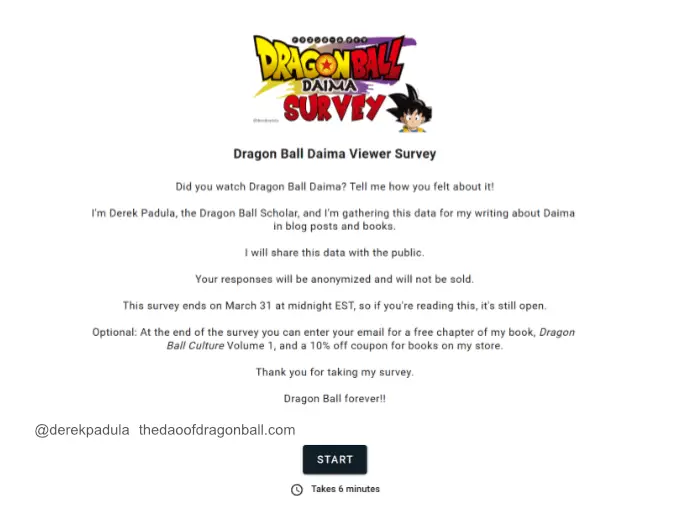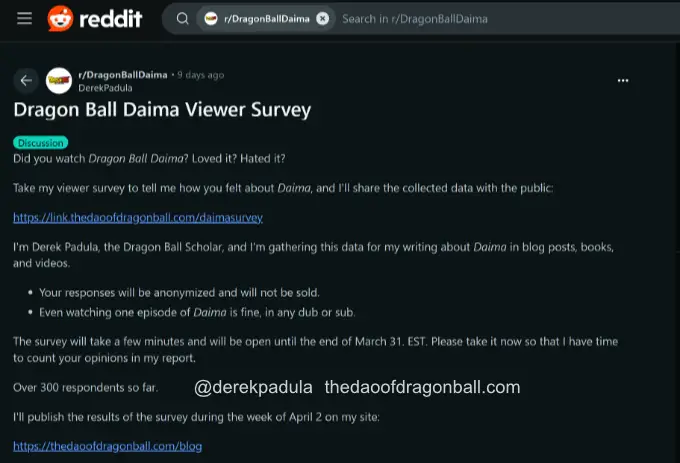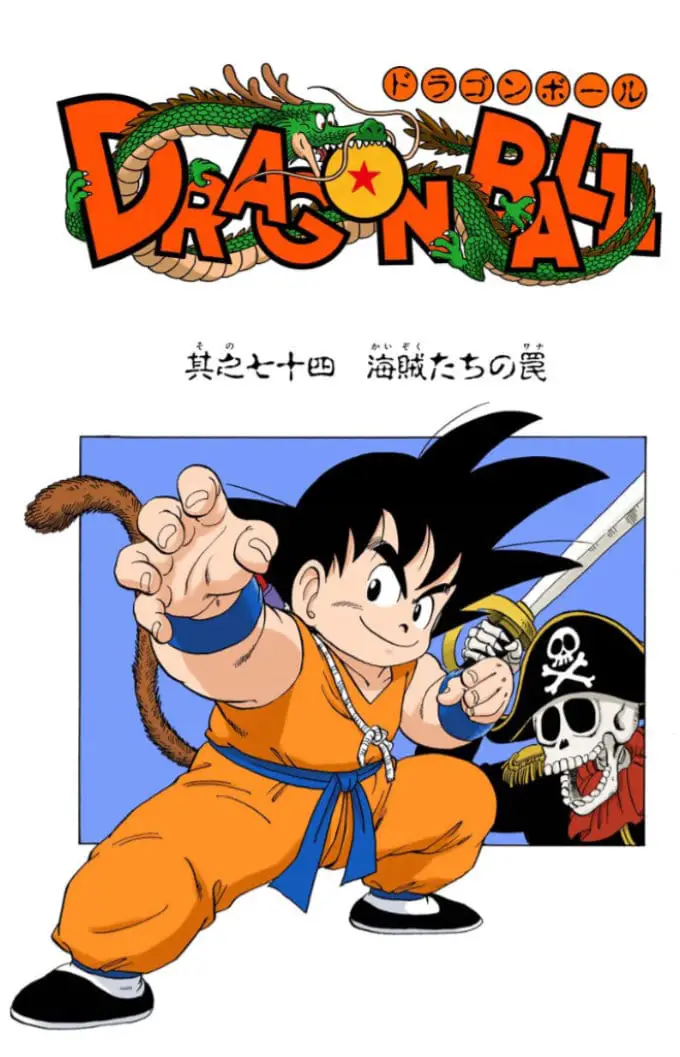Dragon Ball Daima Viewer Survey Results: Part 1

The results of my Dragon Ball Daima Viewer Survey are here! Did Dragon Ball fans love Daima or hate it? Learn what the data from 1,182 fans tells us!
Inside you’ll find some shocking revelations about how fans feel about Dragon Ball Daima, the final project from Akira Toriyama.
Topics include:
- The language of Daima the viewers watched
- Where they watched it
- Overall series rating
- How many episodes they watched
- If they engaged in repeat viewings
- Recommended it or not
- Watched it alone or with others (and with whom)
- Agreed or disagreed with 10 sentiment statements
- How they ranked Daima among other Dragon Ball anime series
- Demographic info, including their age
- Fandom history
- Gender identity
- Location
- Native language
- Personal fan statements about Daima.
I’ll also perform segmentation cross-analysis of this data to gain insights about the fandom and its views on Daima.
Dragon Ball Daima Survey Method

Dragon Ball Daima Viewer Survey Welcome Screen
On March 18, I was writing an article about how many people watched Dragon Ball Daima on Netflix, and on whether or not it was a successful show.
But to write this, I needed to learn more about where else fans were watching Daima aside from Netflix.
To gather this data, I starting making a survey, and in the process my initial goal expanded to include sentiments about the show itself .
On March 24, I launched this survey on the ranked-choice voting site OpinionX.
To promote this survey, I sent out a newsletter to my 2,400 subscribers, posted on my social media of 78,000 followers, posted on several sub-Reddits and forums, asked influencers in the global Dragon Ball community to share it, including YouTubers, and asked a few official Dragon Ball voice actors to share it.

Announcement of my Daima Survey on Reddit’s r/dragonballdaima
I did not use general survey websites or share it on general populace communities. This is because I wanted to hear from Dragon Ball fans, not a general audience.
I told respondents up front in my posts and on the welcome screen that their responses would be anonymized, so they would answer honestly and provide genuine data.
The deadline was midnight at March 31, EST. So it ran for one week.
There was no need to extend the deadline beyond this because the results shifted around for the first two days but solidified by day three. The further increase in responses only increased the overall number of votes, but not the ratio between them.
I had no influence over who responded, and I did my best to reach as wide an audience as possible.
While it might have increased the results from Asia to write posts in Asian languages, target those fans, and extend the deadline, I chose to end the survey and deliver on my initial promise.
Support
I’m giving this data away.
I did not get paid to run this survey and I didn’t sell the data of the respondents.
This survey required 3 weeks of effort to create, run, analyze, and report.
I did this work instead of paid work because I’m enthusiastic about the subject matter.
Please support my work by sharing this original article instead of summarizing it, by following me on social media @derekpadula, by buying my books, and rating the books wherever you bought them.
Your support of my work made this survey possible; and future projects too.
Sample Size

| Participants | Incompletes (Not Counted) | Completion Rate | Average Duration |
|---|---|---|---|
| 1,182 | 236 | 83% | 7m 9s |
There were 1,182 responses. This is an incredible result for any survey. Thank you to everyone who took the survey and shared it!
In general, a sample size of 100 respondents for a survey provides a large enough number to provide a variety of responses and it’s easy to understand the results as a percentage. The larger the sample size, the more statistically significant it becomes.
There are hundreds of millions of Dragon Ball fans in the world, and it’s impossible for them to have all taken this survey, but I wanted to receive a general representation of the fandom.
For example, in a target population of 100,000,000 fans, to achieve a 99% confidence level and a 4% margin of error, I needed an ideal sample size of 1,037 respondents.
Having received more than an ideal sample size, I am convinced that my data provides a statistically significant result that is large enough to represent the global population of Dragon Ball fans.
So let’s dive into the data.
Language

What language did fans watch Dragon Ball Daima in?
| Japanese | Japanese (with subtitles) | English | Spanish | Portuguese | Hindi, Tamil, or Telugu |
|---|---|---|---|---|---|
| 128 | 1,027 | 165 | 13 | 59 | 1 |
Dragon Ball Daima was produced in Japanese for a native-speaking audience in Japan. But it was also streamed in Japanese to a global audience and dubbed into 6 languages (thus far) for region-specific audiences. It’s available in English, Latin American Spanish, Brazilian Portuguese, and the Indian languages of Hindi, Tamil, and Telugu.
For this question, respondents were asked to select all of the languages that they watched the series in.
Given that the question was multiple choice, respondents could have selected multiple languages at the same time. From the 1,182 respondents, there was a total of 1,393 selections, meaning that some viewers watched the show in more than one language.
1,027 respondents (87%) selected that they watched it in Japanese (with subtitles).
The next largest option was English, with 165 selections (14%).
Then, Japanese without subtitles, with 128 selections (11%).
Despite the existence of dubs, so many fans watched it in Japanese with subtitles because Japanese was the first language available to watch on the major streaming sites, and the dubs arrived weeks or months later. For example, the English dub arrived on January 10, 2025, 3 months behind the Japanese.
If you lived outside of Japan and wanted to see the latest episode, you either had to watch it in Japanese or wait, and most fans chose not to wait. To be precise, only 17% of total selections were in a language other than Japanese.
In a later section on the respondent’s demographics you’ll see that the fans spoke 46 different native languages across 6 continents. But it was almost irrelevant because so many fans watched it in Japanese because that’s what was available.
Where Did Fans Watch Daima?

First, a brief history of where Daima aired.
Dragon Ball Daima was available on broadcast TV on the Fuji TV channel, where every Dragon Ball series has aired since its premiere in 1986.
Daima premiered on Fuji TV on Friday, October 11, 2024, at 11:40 pm, JST.
It then became available on other streaming services and limited international broadcast stations.
In Japan, Daima was available on 17 streaming services, including VIU, Docomo, and the Bandai Channel.
Daima was available globally on two services: Crunchyroll (aff) and Netflix.
Crunchyroll is a US-based anime-dedicated streaming service conglomerate of FUNimation, Sony, and Crunchyroll itself. Crunchyroll’s complete library is available in the US, Canada, Europe, Asia, and Australia.
Crunchyroll signed an exclusive deal to premiere Dragon Ball Daima each week.
As a result, Daima first debuted on Crunchyroll on October 11, 2024, with Japanese audio and subtitles turned on by default.
Daima then debuted on Netflix in Asia on October 14, and globally on Netflix on October 18, a full week after Crunchyroll. Every week, it was one week behind Crunchyroll.
Daima was also streamed on Hulu on October 18. Likewise, via the Disney+ and Hulu bundle for international audiences—because Disney owns Hulu.
It was also available on region-specific streaming services. These include Amazon Prime and YouTube (via the Crunchyroll app) in the United States and countries where these apps are available, ADN in France, and HBO Max in Latin America. And it was broadcast on Latin American TV on Adult Swim, and on French TV via Mangas.
Daima is 20 episodes long, so every week on Friday, for 20 weeks (skipping one week on January 3 for a New Year’s break), it would first appear on Fuji TV, then Crunchyroll, and then a week behind on Netflix, Hulu, and other services.
Other language dubs also released on Crunchyroll in the following weeks and months.
So, where did fans watch Daima?
For this question, respondents were asked to select all of the sources that they watched the series on.
| Crunchyroll | Netflix | Hulu / Disney+ | Amazon or YouTube (via Crunchyroll) | HBO Max | ADN |
|---|---|---|---|---|---|
| 541 | 258 | 83 | 23 | 9 | 14 |
| Fuji TV | Mangas (French TV) | Claro Video | Asian streaming (VIU, Bandai, MyVideo, Chungwa, etc.) | Social media (clips, livestreams, reactions) | Pirated (torrents, unofficial streaming sites) |
|---|---|---|---|---|---|
| 13 | 5 | 0 | 0 | 81 | 503 |
541 (46%) respondents watched the series on Crunchyroll.
258 (22%) on Netflix.
83 (7%) on Hulu / Disney+
This equals a combined 882 (75%) watching the biggest three official sources.
Then, a dispersed 64 selections (5%) of official viewership across the other official sources.
Crunchyroll and Netflix have a duopoly on the international anime streaming market, so it’s not surprising that most viewers watched Daima on these two platforms.
But what is surprising is the number of respondents who pirated the show.
584 respondents (43%) watched the show on unofficial sources. This includes torrent downloads, streaming on unofficial sites, and on social media apps where the show was not distributed. That’s 38% of total sources selected.
This means almost as many viewers watched the show on unofficial sources instead of supporting the official release on its primary streaming source, Crunchyroll.
And the 584 respondents who watched on unofficial sources is 1.44 times greater than all other official sources aside from Crunchyroll combined (at 405), including Netflix.
More people pirated Daima than watched on these other platforms.
Why Pirate Daima?

Goku versus a pirate on Dragon Ball Chapter 74’s title page
Since the advent of internet piracy over 25 years ago, Dragon Ball fans and influencers have been advising others to “support the official release.”
In other words: Buy it, so that your money goes to Akira Toriyama, Shūeisha, Tōei Animation, and whichever company licenses the franchise in your area.
Then why did so many fans pirate Daima?
Due to Daima’s delayed release schedule on other services beyond Crunchyroll, it would be logical to presume that most diehard Dragon Ball fans would watch Daima on Crunchyroll first—and my data supports this argument.
But fans who couldn’t watch Daima on Crunchyroll had 3 options.
- 1) Wait a week to watch Daima on Netflix, Hulu, or other services.
- 2) Watch a pirated version of Daima after it aired on Crunchyroll because they didn’t want to wait.
- 3) Watch social media influencers talk about Daima with clips and summaries, or watch their reactions to the show with a livestream of Daima in the background.
Social media influencers would often spoil each episode of Daima the day it premiered on Crunchyroll. They would reveal the plot points and exciting moments in order to gain more ad revenue and followers.
Did this behavior by influencers increase the number of viewers who watched it on Crunchyroll because they were hyping it up?
Did it increase the amount of piracy due to this hype?
Or through the act of spoiling the highlights, did it reduce the number of viewers who would watch the episode on an official source; especially a week later?
There’s no way to be certain because there are too many factors at play and these streaming services don’t release their data.
This one comes down to subjective opinion, so I’d like to hear your thoughts.
Rise of Piracy Hurting Dragon Ball?
The data in this survey brings up an age-old issue when it comes to piracy of anime.
From what I can surmise, 66–83% of all anime fans pirate anime; it’s hard to find exact numbers due to the nature of piracy.
So by comparison, 43% of Dragon Ball fans pirating Daima is lower than typical.
Maybe this lower piracy rate was because the message about supporting the official release got through to fans in regard to Dragon Ball? Or maybe this was due to fans paying respect to Akira Toriyama’s spirit and the connection they had with his work? I did see fans say the latter online.
In any case, the battle between official sources and viewers who pirate content has raged for decades. Their support of piracy has led to pirate sites that are often bigger than official sites.
According to TorrentFreak on January 4, 2025, the anime pirate site HiAnime (previously branded as AniWatch) outranked Disney+ in the U.S. for monthly site visits, with 364 million monthly visits in October, 2024. This is three times the traffic of Crunchyroll.com.
In fact, anime, and manga in particular, are now the number 1 source of pirated content online.
It’s reached the point where fans debate whether you can even be called a “true” anime fan if you don’t pirate it.
Quick argument summary from those who pirate: If you enjoy anime, you’re a fan, whether you pay for it or not—simple as that.
But other fans make the counterpoint that it costs a lot of money to make anime, and voice actors, producers, writers, animators, and composers can’t produce art without getting paid for their work.
Many initiatives and takedowns have been enacted against the pirates by national governments, but they keep growing.
In the U.S., Zoe Lofgren, a federal Democratic Congresswoman from California, proposed a bill on January 29, 2025 called “The Foreign Anti-Digital Piracy Act.” Her bill’s press release claims, “Intellectual property theft drains at least $30 billion and 230,000 jobs from the U.S. economy each year.”
How did we get here? In the mid-to-late 2000s, anime streaming services were just starting out and their quality was poor. By comparison, most pirated torrents made by fans arrived sooner and were higher quality.
But nowadays, official streaming services are easy to access, often have new releases come out on the same day as in Japan, are affordable, and provide high-quality content with accurate subtitles. They’re not perfect, but perform well most of the time.
Pricewise, Crunchyroll is $8 a month, Hulu is $14, and Netflix is $18.
With 4 episodes of Daima released a month, that’s $2 an episode on Crunchyroll. Then at 20 episodes, that’s $40 to watch the entire Daima series and everything else on their platform while subscribed.
Yet that price was still too high for 43% of respondents?
Maybe price isn’t the issue. People also pirate anime because of a lack of access to the official source for a certain show in a specific country; wanting to watch classic works that are no longer available; lack of payment options; not wanting to support the official release because of anti-capitalist, anti-rich, anti-censorship, or pro-piracy ideologies; or vowing that they’ll buy the home release on disc when it’s published months or years later.
Another factor is the decline of traditional TV watching and the rise of social media and apps. Younger demographics prefer to watch short-attention span programs on their devices instead of a TV and don’t want to pay for what they’re used to getting for free.
But the counterpoint here is that all of these streaming services have video on-demand apps that can be accessed on any device.
And as you’ll see in later sections of this report, most viewers of Daima who took this survey were adults, not kids, so they have more options to access the official source. But kids also pirated it.
Whatever the causes and justifications, the end result is that piracy of Dragon Ball remains rampant.
But is it hurting Dragon Ball?
Tōei Animation’s latest financial report shows that Dragon Ball was this year’s most lucrative shōnen anime franchise (eclipsing One Piece).
So, by and large, no, Dragon Ball is not hurt by this piracy.
Whether or not the streaming services are hurt by it is another question.
Conclusion of Part 1
How do you feel about fans watching Daima mostly in Japanese, the sources that they watched it on, and the continued piracy?
There’s more to discuss in these Daima survey results.
Come back next week for Part 2, where I’ll reveal how fans rated Daima overall, how much of it they watched (and with whom).
Then in Part 3 and 4, with how they felt about 10 different aspects of the series (including the writing!).
Then in Part 5, how they ranked Daima among other Dragon Ball anime series.
Finally, in Part 6, we’ll explore the demographics behind these numbers and why people feel the way that they do.
Please share this article with your fellow Dragon Ball fans!
Update: Read Part 2
' . $comment->comment_content . '
'; } } else { echo 'No comments found.'; }